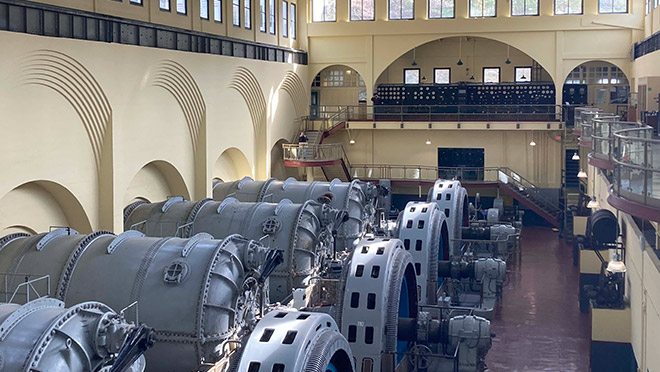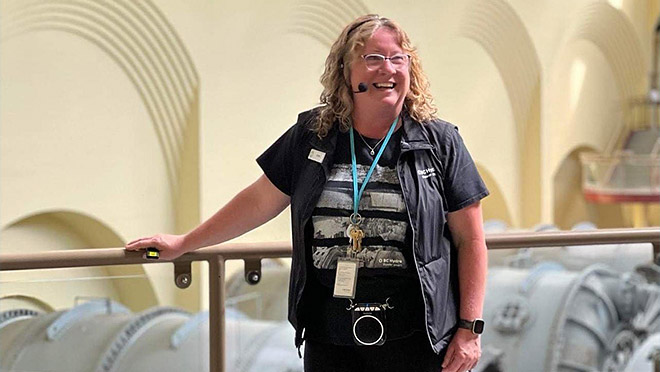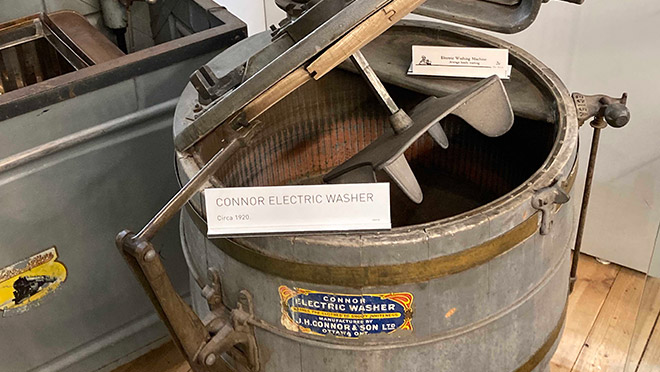Inside the Powerhouse at Stave Falls with an electric guide

Visitor Centre leader Schultz brings life to museum's treasures near Mission
A couple visitors not interested in taking a guided tour of the 111-year-old Powerhouse at Stave Falls changed their minds quickly as they started tagging along with Janis Schultz on a warm mid-weekday in March.
Touring the hydroelectric facility and museum with Schultz is akin to strolling with Michelangelo through the Sistine Chapel. Except that Schultz is very much alive, with a torrent of anecdotes, facts and – if you ask for them – technical info that will make your head spin like... well, a turbine.
With her wit and astounding memory, Schultz paints a stunning picture of what it was like to work at the powerhouse, which became a museum – and a National Historic Site – after it was replaced with a new powerhouse in 2000. And she should know.
"I grew up in the townsite of Stave Falls, which was taken down in the early 1980s," says Schultz. "My great grandpa came over from England to work here, and helped build this power station."
Schultz's self-professed "packrat" approach to collecting stories is a big reason the Powerhouse at Stave Falls is one of BC Hydro's most popular visitor centres. As of mid-March, school groups were booked solid, up to six groups per day, for the next three months. And on this day, a couple of seniors were visiting with their grandkids, something they do three or four times a year on an annual family pass.
The Powerhouse at Stave Falls is the only BC Hydro Visitor Centre to open in the early spring, and it's open 10 a.m. to 4 p.m., seven days a week through June 26 before shifting to five days a week (closed Tuesdays and Wednesdays) in the summer. With school groups back in the mix in the fall, it shifts back into 7-day-a-week mode September 14 to October 9. And Hayward Lake below Stave Falls is a year-round joy for paddlers.
BC Hydro's Revelstoke and W.A.C. Bennett Dam Visitor Centres open seven days a week from May 20 to September 4. Admission costs at all Visitor Centres is $8 for adults, $7 for seniors and youth, and it's free for those five and under.

Why is the powerhouse so popular? There's something for everyone
Not convinced you want to walk among massive turbines in a century-old powerhouse? How about watching a mini lightning bolt created by a Tesla coil, or seeing a 1912 electric car. Or walking through a gallery of antique electric washing machines, fridges, and hair appliances.
"This is just a washer with a spinner," says Schultz, pointing to a washing machine from around 1920. "And then you'd have to dry your clothes. A woman donated this to us because she couldn't get it fixed anymore. She bought a newer version... and she hated it."
At one point, we stop at a table in the great hall of the powerhouse, where there's a framed cheque from 1950.
"This is grandpa's cheque for four cents," says Schultz, with a big laugh, as if seeing it for the first time. "And this is his 25-year certificate, signed by [former BC Electric Company president] Del Grauer.
"And my grandpa made this," she says, pointing to the frame around the cheque. "He was a general contractor, which back then was called a carpenter, but they call them a GT now. And all our furniture looks like this: cedar inlay."
The Stave Falls Visitor Centre isn't just a glance back to the construction of the dam and powerhouse a century ago. There are exhibits on hydroelectric generation, renewable and non-renewable resources, human and natural heritage, and conservation. For kids, there are a lot of hands-on exhibits that allow them to explore, see and hear how energy is created.
If you take a kid to the powerhouse, don't forget to pick up a copy of the scavenger hunt game to keep them searching for items as they explore the powerhouse and museum. Consider joining a tour to get intriguing insights from Schultz or one of the whip-smart guides on her team.
At one point, Schultz stops at the top of a set of steep steel stairs that lead from the second level of the powerhouse to the generator floor.
"This is the original staircase, and the workers used to slide down the stairs," she says. "One of the Power Pioneers [retired former BC Hydro workers] told me his job was to polish the brass railings in the early 1960s. He didn't like doing it, so he put brass polish on rags, put them under his armpits and kneepits, and slid down the railings."

Things to do while visiting Stave Falls: Hayward Lake and beyond
The Powerhouse at Stave Falls is part of a hydroelectric system that employs three reservoirs that supply three generating stations. It starts with water stored in Alouette Lake, runs through Alouette Generating Station into Stave Lake, flows through the new powerhouse at Stave Falls into Hayward Lake, and finally through Ruskin Dam and Powerhouse before spilling into the Fraser River three kilometres south.
The reservoirs are popular recreation areas, and can make for a full day of fun when combined with a visit to the Powerhouse at Stave Falls. Swimming, hiking, biking, fishing and boating are all options, and Hayward Lake in particular gets busy in summer as swimmers and paddlers arrive in big numbers.
While you're in the area, and in particular if you've made the 50- to 70-minute long drive from Vancouver, don't miss out on some of the other charms of the valley, including:
- Mission, which features the drag strip at Mission Raceway, dining at the Blackberry Kitchen restaurant, the huge deck and family-friendly daytime menu at Dewdney Pub.
- Cafes and restaurants Big Feast Bistro and Catering in Maple Ridge, Corona's Mexican in Mission, and the Kilby Cafe at the Kilby Historic Site in Harrison Mills.
- Sandpiper Golf course, located along Highway 7 near Harrison Mills.
- Indoor and outdoor thermal pools, and perhaps an overnight stay, at Harrison Hot Springs Resort.
- Craft beer at Maple Meadows Brewing and Billy Miner Alehouse & Cafe in Maple Ridge, Hubco Brewing in Mission, and if you're making the loop back to Highway 1 through Abbotsford, Old Abbey Ales Brewing.